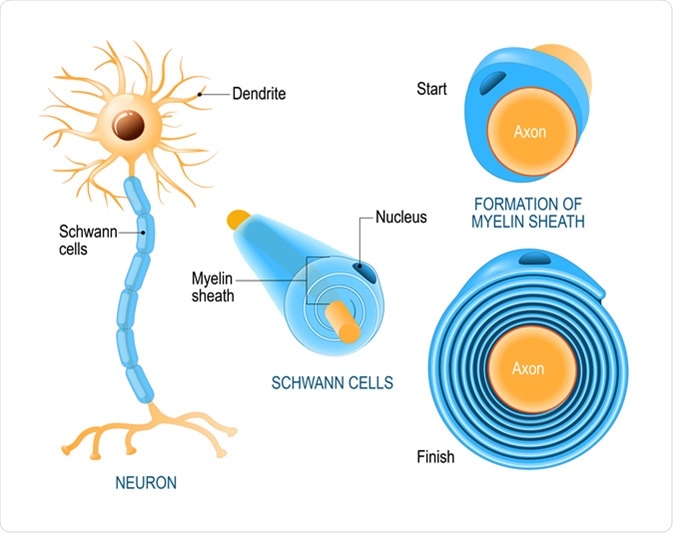Describe the Three Different Forms of Schwann Cells
Myelin is formed by Schwann cells in the peripheral nervous system PNS and oligodendrocytes in the central nervous system CNSEach Schwann cell forms a single myelin sheath around an axonMyelin itself forms by the spiral wrapping around an axon of an enormously expanded glial plasma membrane that then compacts. In addition we describe three different methods to evaluate axonal regeneration using quantitative methods.
What Is The Function Of Schwann Cells In Unmyelinated Axons Quora
The most common type of glial cell in the central nervous system is the astrocyte which is also called.

. Gaps in the myelin sheath of the axons of peripheral neruons. Also there are different types of glia and this is determined by their location and function. Mostly in brain and spinal cord.
Schwann cells Neurons are specialized nervous tissue cells that function to conduct signals to and from and the brain. There are different types of glial cells in the nervous system such as astrocytes Ependymal cells oligodendrocytes microglia and Schwann cells. Describe the three types of neurons classified on the basis of structure.
Schwann cells which form myelin sheaths around 1. Schwann cells which form myelin sheaths around peripheral axons. Microglia scavenge pathogens and dead cells.
It is made up of many layers of Schwann cells. The neurons are responsible for the conduction and transmission of the nerve impulses. Astrocytes oligodendrocytes and microglial cells Figure 14ACAstrocytes which are restricted to the brain and spinal cord have elaborate local processes that give these cells a starlike appearance hence the prefix astro.
For one oligodendrocytes are only found in the central nervous system - the brain and spinal cord. These protocols constitute a valuable tool to analyze in vitro mechanisms associated to axonal degeneration and regeneration of sensory neurons and the role of Schwann cells in these processes. What Are Glial Cells and What Do They Do.
The receives the signal the _ conducts the nerve impulse and the --_____ contains the organelles of the. The outermost layer of Schwann cells. When a nerve impulse is conducted along a myelinated fiber it jumps from node to node.
Action potentials can hump from node to node thus increasing the speed of conduction saltatory conduction. Form the blood brain barrier Surround the soma and insulate it Produces the CSF 5. Wraps many fibers with myelin e.
Supporting cells of the peripheral nervous system responsible for the formation of myelin. Pair the neuroglia with their function. A myelinated axon is wrapped in multiple thin layers of the plasma membrane.
However in a different arrangement a Schwann cell can enclose many up to 20 unmyelinated axons. Their main purpose is to help information move. Each Schwann cell myelinates only one axon where one peripheral axon will have multiple Schwann cells myelinating its length as one Schwann cell wraps a lipid-rich membrane layer around approximately 1 mm of an axons length.
Astrocytes oligodendrocytes microglia and ependymal cells located in the Central Nervous System. 1 multipolar neuron one axon rest of dendrites. And Schwann cells Satellite cells and Müller cells found in the Peripheral Nervous System.
The Schwann cell then begins to wrap the axon in folds of plasma membrane from which cytoplasm has been excluded. The first three types of cells are found in the central nervous system and Schwann cells are found in the peripheral nervous system. A Schwann cell first surrounds a portion of an axon.
The major function of astrocytes is to maintain in a variety of ways. Describe the series of events which occur at a synapse. Schwann cells such as oligodendrocytes in the central nervous system form a myelin sheath around the axons of the nerve cells or neurons 3.
Ependymal cells produce cerebrospinal fluid that cushions the neurons. These cells are found in different parts of the nervous system. Maintain blood brain barrier structural support regulate ionnutrientgas concentrations absorb and recycle neurotransmitters form scar tissue after injury.
This type of conduction is called saltatory conduction. Axon cell body They consist of three parts. Glial cells also known as neuroglia are an essential part of the nerve tissue.
Glial cells of the b peripheral nervous system include Schwann cells which form the myelin sheath and satellite cells which provide nutrients and structural support to. Astrocyte Oligodendrocyte Microglia Ependymal cell Satellite cell Schwann cell. Oligodendrocytes come from neural stem cells.
Produces myelin around a singular b. There are six types of neuroglia each with different functions. Myelination of peripheral axons and repair after injury -Oligodendrocytes.
Complete the following paragraph to describe different nervous tissue types. These are gaps left by a myelin sheath. And satellite cells or ganglionic gliocytes which support 2.
2 bipolar neuron two processes 1 axon and 1 dendrite specialized parts eyes nose ears 3. Satellite cells which support neuron cell bodies in the PNS. On the other hand Schwann cells are found in the peripheral nervous system.
Between adjacent Schwann cells is a small gap called a node of Ranvier where the nerve fiber is exposed. Myelinate CNS axons and provide structural framework -Astrocytes. There are three types of glial cells in the mature central nervous system.
It is the cytoplasm of an axon. Schwann cells myelinate the nerve cells that project to and from our muscles internal organs and the other signals in the peripheral nervous system. Neuron cells bodies within the ganglia of the PNS.
The supporting cells of the peripheral nervous system are Schwann cells and amphitic satellite or capsular cells that are present in ganglia.

What Is The Role Of Neuron Schwann Cells Quora

Organization Of Myelinating Schwann Cells Schematic Organization Of Download Scientific Diagram

No comments for "Describe the Three Different Forms of Schwann Cells"
Post a Comment